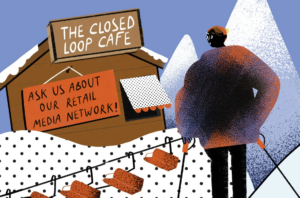 “Data-Driven Thinking” is written by members of the media community and contains fresh ideas on the digital revolution in media.
“Data-Driven Thinking” is written by members of the media community and contains fresh ideas on the digital revolution in media.
Today’s column is written by Mike Baker, CEO at DataXu.
All marketers are rightly daunted by the cost and complexity of collecting vast quantities of consumer data and connecting it to their specific tastes in real time. While the concept of one-to-one marketing sounds great for the consumer – who wouldn’t want to receive a text message from a favorite brand when cool products are on sale? – is it really worth the time and expense required to do it right?
Any one-to-one marketing scheme requires stores and brands to keep extraordinarily detailed records on their customers. And it requires some mechanisms for determining when a consumer’s taste or preference has changed even slightly. How is that possible?
The lesson here is simple: Consumer data should inform the types of communications we send to a customer, such as one who is interested in trendy fashion, while not attempting to be overly deterministic of how every data point should be used.
I haven’t seen any hard evidence that the data technologies required to facilitate that level of one-to-one marketing create bottom-line profit. There is, on the other hand, proof that DSP-enabled ad optimization can substantially increase marketing ROI.
For the record, I’m completely pro-DMPs integrated with DSPs and I’m a data advocate. But like everything in life, it comes down to degree. That’s where a heuristic approach comes in.
“In computer science, artificial intelligence and mathematical optimization, a heuristic is a technique designed for solving a problem more quickly when classic methods are too slow, or for finding an approximate solution when classic methods fail to find any exact solution,” according to Wikipedia. “This is achieved by trading optimality, completeness, accuracy or precision for speed.”
Don’t be frightened by the term “trading optimality.” Optimal isn’t always required. Let’s say you have three suitcases and two boxes to fit into the trunk of your car. You can place the biggest cases in first, and fit the boxes around them. Or you can create a 3-D model of your trunk, along with 3-D images of the items you need to go in it. From there you can develop the most optimal arrangement. But if your goal is to simply get the items from point A to point B in your car, isn’t the first approach – which is to say heuristic – the best use of your time and resources?
Going back to one-to-one marketing, is it adequate (suboptimal to be sure) to message consumers with news of a sale when they are in the immediate vicinity of a retailer with whom they have a long-term affinity? Will this heuristic approach be enough to lure in the faithful?
The kind of rules-based, deterministic data that one-to-one marketing schemes demand requires organizations to make vast investments, which at the end of the day, necessarily focus on upsell and cross-sale of existing customers. Shouldn’t investments on that scale concentrate on attracting new customers to the brand so you can ultimately grow your business?
AdExchanger Daily
Get our editors’ roundup delivered to your inbox every weekday.
Daily Roundup
In my opinion, an ideal solution is one that seamlessly incorporates deterministic and probabilistic decision-making with smart campaign management.
First, use the consumer data you can easily collect and activate online, such as customer site visits and conversions, to remarket specific products, including cross-sell and upsell. Then leverage the data you have through a DSP with a learning system that can target prospects with similar attributes as your best converters, test messages in real time and collect more behavior data to improve outcomes. This is a really good “probabilistic” decision-making approach that is smart, fast, scalable and inexpensive.
Use a combination of rules-based (deterministic) and inference-based (probabilistic) decision rules to run your campaign. Apply the rules-based decisioning first, but in the absence of consumer ID or cookie data, let the inference decisioning kick in.
I bet you’ll get a lot more conversions.
Follow Mike Baker (@michaelkbaker), DataXu (@DataXu) and AdExchanger (@adexchanger) on Twitter.













